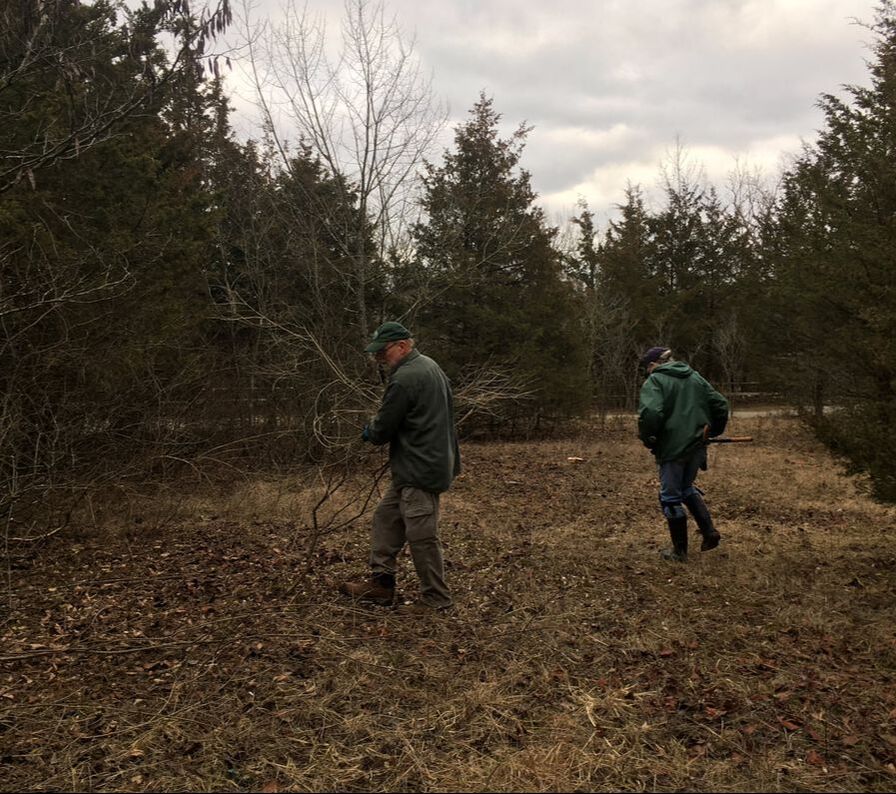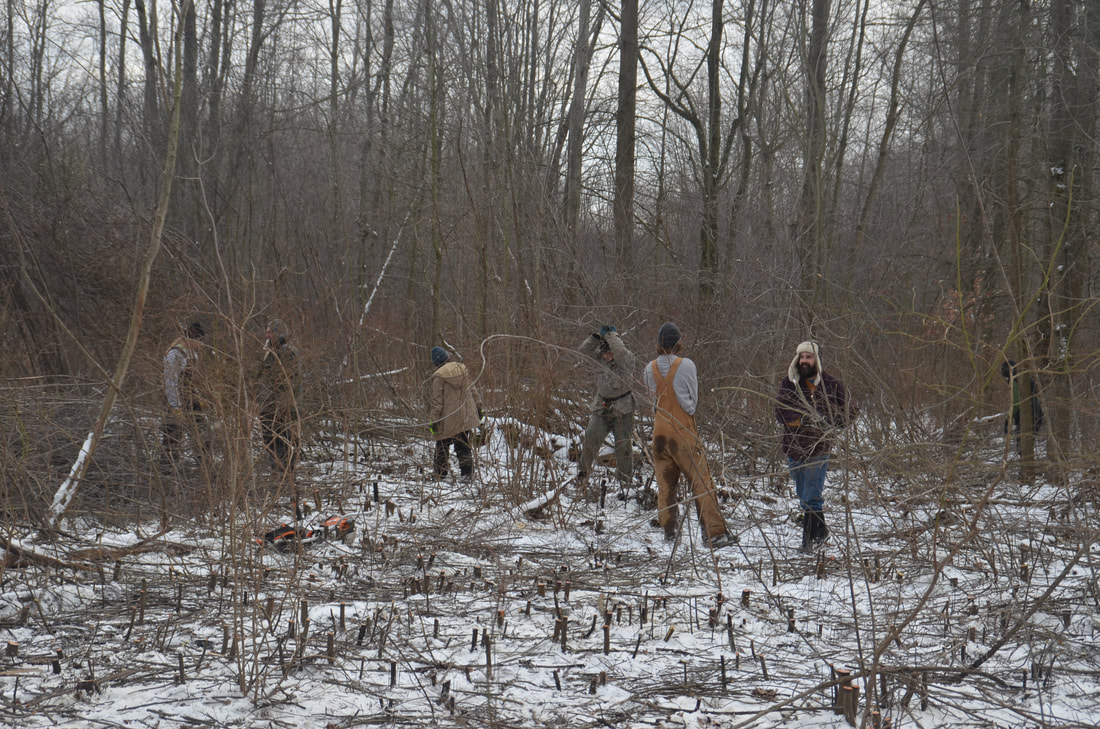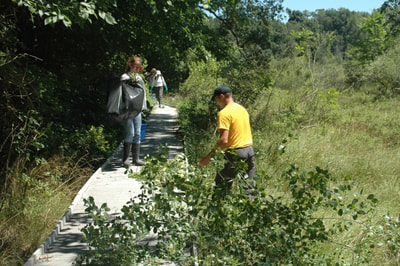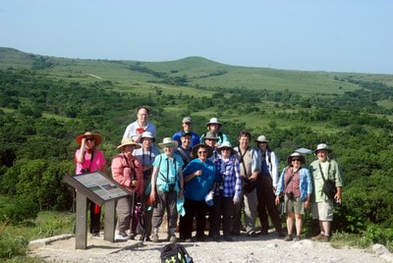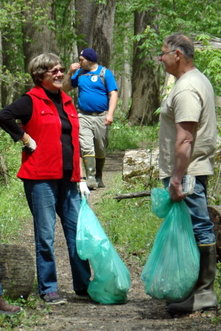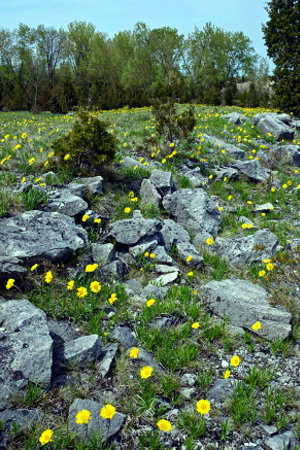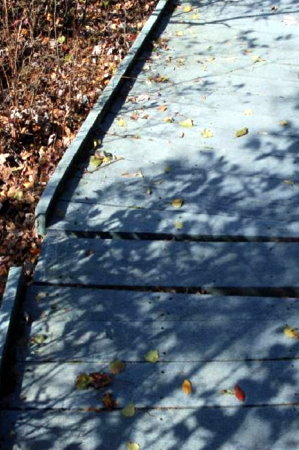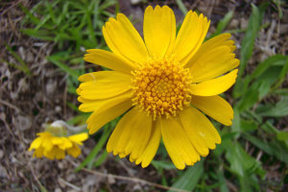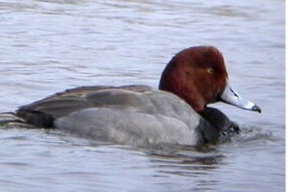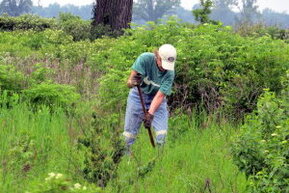Tour of Denny's Tallgrass Prairie set for Saturday, July 27, at 10 am to 1 pm
|
Registration not required.
Several prairie experts will be on hand to guide small groups through the native flora of the prairie situated in Knox County. Members and friends are invited to tour the gently rolling landscape in peak bloom: compass plants, royal catchfly, coneflowers, cup plants, and so much more host a gathering of butterflies, bees and other pollinators, during the tour. The prairie was created on 20-plus acres of once-cultivated farmland and also features two ponds with native hibiscus, gentians and other natives that thrive in wetter conditions. This “free to the public event" takes place at Denny’s Tallgrass Prairie which is a 20-plus acre prairie located in Knox County about 45 minutes north of Columbus. The street address is 6021 Mt. Gilead Road (SR95) Fredericktown, Ohio. From the junction of Interstate 71 and State Route 95, follow SR95 east just under 5 miles to the |
Photos by Terry Duncan & Jan Kennedy
Knox County Line Just about 20 feet beyond on the North side of SR95 is the driveway where there will be an ONAPA events sign directing participants up the drive to the designated parking area.
|
In April 2010, the Knox County Park District, with financial assistance from the Clean Ohio Fund Green
Space Conservation Program, acquired a 348-acre property located across the road from the Honey Run
Waterfall. The park includes hiking trails, picnic facilities and habitat restoration
(warm season grasslands/prairie forb areas and tree plantings). During the 2021 growing season,
park volunteers identified a total of 320 species of forbs.The park includes 60 acres of planted prairie,
on which ONAPA assists with the prescribed burning in the spring.
Directions: The entrance to Honey Run Highlands is on Millersburg Road or State Route 62. Follow the
gravel road back to the second parking lot. We will work at one of the grassland units near this parking
lot.
What to bring: Bring lunch, work gloves, hiking boots, tick spray or repellent, and water. ONAPA will provide the tools.
RSVP: Please REGISTER HERE. Online registration is important for our planning. If you have questions, please contact The Ohio Natural Areas and Preserves Association HERE.
Space Conservation Program, acquired a 348-acre property located across the road from the Honey Run
Waterfall. The park includes hiking trails, picnic facilities and habitat restoration
(warm season grasslands/prairie forb areas and tree plantings). During the 2021 growing season,
park volunteers identified a total of 320 species of forbs.The park includes 60 acres of planted prairie,
on which ONAPA assists with the prescribed burning in the spring.
Directions: The entrance to Honey Run Highlands is on Millersburg Road or State Route 62. Follow the
gravel road back to the second parking lot. We will work at one of the grassland units near this parking
lot.
What to bring: Bring lunch, work gloves, hiking boots, tick spray or repellent, and water. ONAPA will provide the tools.
RSVP: Please REGISTER HERE. Online registration is important for our planning. If you have questions, please contact The Ohio Natural Areas and Preserves Association HERE.
|
Thursday, August 1, 2024
Japanese Stiltgrass Control at Warder-Perkins Preserve 11:00 am - 4:00 pm Cleves Road Church, 8575 S.R. 264, Cleves Hamilton County The Audubon Society acquired this property as a gift from Ethel Perkins, a member of the Chapter since 1915 who served on the Board of Directors during the 1960's. She and her husband acquired the property from Dr. John A. Warder's estate. Dr. Warder was the founder of the Cincinnati Park Board and also helped establish the American Forestry Association. The heart of this preserve is situated in a beautiful stream valley. The most significant species found growing here is the state listed running buffalo clover (photo). The preserve has a good spring wildflower display and impressive large trees. We will be working in the area of the running buffalo clover to remove Japanese stiltgrass and other invasive plants. We will hike into the preserve from the right back of the parking lot behind the church. |
We will be working in the area of the running buffalo clover to remove Japanese stiltgrass and other invasive plants. We will hike into the preserve from the parking lot behind the Crossroads Church in Cleves.
What to bring: hiking boots, gloves, lunch, and water. RSVP: Please REGISTER HERE. Online registration is important for our planning. If you have questions, please contact The Ohio Natural Areas and Preserves Association HERE. |
|
July field trip to Clifton Gorge State Nature Preserve covers geology and more ONAPA had another excellent field trip on Thursday, July 11 at Clifton Gorge State Nature Preserve, with retired DNAP preserve manager and ONAPA Board member, Tim Snyder leading the trip. Tim primarily spoke about the geology of the preserve, but as an excellent naturalist, he discussed other aspects of the preserve and its ecology. Fourteen (14) people attended the field trip which lasted almost three hours. Tim shared many interesting legends about the history of the Clifton Gorge area and kept the group entertained. Tim's book, Rainbows of Rock, Tables of Stone - about rock arches in Ohio - was offered to attendees at the end of the field trip. |
Giant Swallowtail one Ohio butterfly that will not go unnoticed this summer
|
Photo and story John Watts
As one strolls into the middle of summer, the bird songs begin to wind down and it’s time to look for other species. Butterfly occurrences peak in the summer months, especially in terms of numbers with 137 species of butterflies and skippers recorded for Ohio. Many of these species are small and can go unnoticed. The Giant Swallowtail is not, however, one of those species. With a wingspan of 4-6.5 inches this large, dark brown butterfly with two rows of bright yellow spots across the top of its wings has a strong but almost effortless flight pattern which an make them a challenge to follow. The underside of the wings is a bright creamy-yellow with a blue median |
spot band on the hindwing. This avid flower visitor nectars on a wide variety of summer wildflowers but is limited to two species of plants as a larval food source. The larva feed on the shrubs Prickly Ash (Zanthoxylum americanum) and Wafer Ash (Ptelea trifoliata), both members of the Rue or Citrus (Rutaceae); the same family that includes: oranges, lemons, and limes. While Prickly Ash and Wafer Ash are widespread in Ohio and can form dense stands in open, moist woods and calcareous banks. Where one finds those types of populations, the Giant Swallowtail is likely to be fairly common. In Ohio, both of these plants are more common in the western half of the state and Giant Swallowtails is fairly uncommon in the eastern and southeastern portions of our state.
The butterfly appears annually in two broods: one in late May and early June and the second during the second half of July and August. The second brood seems more prolific in most years and individuals are larger during the spring brood. While often seen flying quickly by, if you happen upon a mineralizing individual (possibly recently emerged) and you are patient and move slowly, it is possible to capture photos of them in flight as they lazily drift from spot to spot. It can be a wonderful experience to watch the movement of such a large butterfly with an almost tropical looking appearance right here in Ohio.
The butterfly appears annually in two broods: one in late May and early June and the second during the second half of July and August. The second brood seems more prolific in most years and individuals are larger during the spring brood. While often seen flying quickly by, if you happen upon a mineralizing individual (possibly recently emerged) and you are patient and move slowly, it is possible to capture photos of them in flight as they lazily drift from spot to spot. It can be a wonderful experience to watch the movement of such a large butterfly with an almost tropical looking appearance right here in Ohio.
|
Stewardship Assistants: Two new faces arrive in 2024 for a total of three to help in the field
This season, ONAPA has three stewardship assistants: Lydia Radcliffe, Alyssa Mills, and Maya Moore. Lydia is returning for her fourth season and also works as a part-time naturalist at Blendon Woods Metro Park in Columbus. She is a wonderful asset to ONAPA as she started in 2021 and has plenty of experience with our projects and volunteers. Both Maddie and Mariola now have full-time jobs, Maddie at Cedar Bog and Mariola with the Stream & Wetlands Foundation. Alyssa and Maya are new with ONAPA this season. Alyssa has a variety of experiences, having last worked for the Tinker's Creek Watershed Partners in Twinsburg. She |
completed her undergraduate degree in Agriculture at OSU in 2009. She is now working on her Master's degree at OSU in Wooster and is excited to gain more field experience with ONAPA. Maya completed her undergraduate degree in Zoology at Ohio Wesleyan University in May of this year. She is originally from central Pennsylvania and is interested in learning more about plants and getting field experience in natural areas around Ohio.
We are thrilled with our stewardship assistants and happy to have them join the ONAPA stewardship team!
We are thrilled with our stewardship assistants and happy to have them join the ONAPA stewardship team!
June may not be traditional "dog days of summer" but it sure felt like it!
|
June was a busy month for our stewardship assistants and volunteers with some very hot, humid days. We worked on sweet clover at Chaparral Prairie (June 4), sweet clover and other invasives at Milford Center Prairie (June 18), and teasel at Daughmer Savanna (June 29).
We also visited Cranberry Bog to check out the results of our fall clearing project in the bog meadow, which is looking great. We spent three long days conducting surveys at seven sites for the Eastern prairie fringed orchid with the US Fish & Wildlife Service and other partners. We are grateful for everyone's hard work, especially on some grueling hot days. Thank you! |
|
|
Warm temperatures and raindrops part of May activities that included seed gathering and garlic mustard pulls
May proved to be a busy month for the ONAPA stewardship team. With rain and warm temperatures, many wildflowers and invasive plants, such as garlic mustard and Dame's rocket, were ahead of schedule which caused problems for our scheduling. For example, Lakeside daisy started blooming in mid-April this year, two weeks earlier than normal, so plants were going to seed in mid-May. We had to scramble for our seed collecting and did not get as many seeds. We collected Lakeside daisy seeds for two days; these seeds will be distributed in the fall at the new section of the preserve on Alexander Pike in Marblehead. Stewardship projects were held at Miller Preserve, Lake Katharine, Clifton Gorge, Irwin Prairie, and Davey Woods to remove garlic mustard, Dame's rocket, and butterweed. Stewardship assistants tackled the steep walls at Miller Nature Sanctuary in search of invasive garlic mustard. |
April stewardship projects involve various methods of invasive plant control
|
April proved to be a busy month for ONAPA with four stewardship projects and four days of prescribed burns, helping other partners. The weather continued to be challenging so we had to reschedule two projects due to rainy weather. We worked at Fowler Woods on garlic mustard (April 16), Spring Beauty Dell (photo) with Great Parks on Amur bush honeysuckle (April 18), Collier Preserve on garlic mustard (April 20 for Earth Day), and Kendrick Woods with Johnny Appleseed Metropolitan Park District on garlic mustard (April 23). These were all busy days with plenty of garlic mustard and honeysuckle to remove! Our Earth Day project at Collier Preserve was especially fun with 17 people, including 11 students from the OSU Botany Club.
ONAPA conducted prescribed burns on five different days, one in late March at Cedar Bog and the others in April - Wolf Run Regional Park with Knox County Park District, Brinkhaven Oak Barrens with the Killbuck Watershed Land Trust, Foxfield Preserve with The Wilderness Center, and |
Cooke Family Wildlife Conservation Park and Cool Springs
Wildlife Conservation Park with the Ashland County Park District. All of these burns involved working with several partners to help them gain more experience with prescribed burning. We could not have completed all these burns without their help! |
Several March projects scheduled between the month's rainy weather days
|
Despite some rainy weather, we managed to accomplish five stewardship projects in March. We had two days of hemlock wooly adelgid surveys at Lake Katharine, on March 7 and 21. Unfortunately, HWA is pretty widespread in the preserve, but these surveys will help DNAP determine the best locations for pesticide treatments this summer.
We also worked on woody species removal at Cedar Bog (March 12), Medway orchid site (March 19), and Travertine Fen (March 28). These are all fen or sedge meadow habitat where woody species control is critical to maintaining the plant community and rare species. We were fortunate to have large groups on all three days, 18 people or more each day. |
|
Small prairie openings at Greenville Falls get attention from ONAPA
|
Story and photos by Lydia Radcliffe
ONAPA had its first project at Greenville Falls State Scenic River Area February 15. The day turned out to be an excellent opportunity for partner organizations to work together. This site is managed by the Miami County Park District. Last summer, Jennifer Windus and others from ONAPA’s stewardship team met with the park district’s natural resources management staff, Trevor Diegel and Hailey Demmitt, to visit Goode Prairie State Nature Preserve and Greenville Falls State Scenic River Area to explore opportunities for future collaboration with stewardship projects at one or both sites. This winter’s stewardship project at Greenville Falls was a result of those discussions and focused on removing woody vegetation in the small prairie openings north of Greenville Creek. In addition to ONAPA stewardship volunteers and Miami Park District staff, DNAP preserve manager, Michelle |
Comer and Scenic Rivers staff, Bela Clutter, Rowan Coburn-Griffis, and Autumn Moore also came out to join the effort. A reporter for local WYSO radio station,
Adrianna Martinez-Smiley also participated to collect information for a story on ONAPA and this stewardship project. Our group of fourteen made significant progress in opening the prairie areas up for prairie plants such as grey-headed coneflower, butterfly weed, and nodding wild onion. The team was able to thin and clear cedars, basswood, Asian bush honeysuckle, autumn olive, and other woody vegetation from four prairie clearings. One of these overlooks the limestone cliffs along Greenville Creek; such areas at this site are home to rare plants including rock sandwort, harebell, tufted hairgrass, limestone savory, and wand lily. Projects like these exemplify ONAPA’s role in bringing together like-minded organizations to accomplish valuable stewardship work. The Miami County Park District is one of ONAPA’s newer partners, and thus far natural resources staff there have been more than welcoming to the assistance ONAPA has offered for their high-quality natural areas. We are grateful to the many hands that came out to help at Greenville Falls, and we look forward to more collaborative projects in the future! |
January greets stewardship volunteers with weather challenges in the field
|
January weather was challenging, but we managed to complete three stewardship projects, even with rescheduling two of them. Two were new projects, OSU Marion Prairie on January 11 and Castalia Quarry Metro Park on January 25.
At OSU Marion campus, we helped remove woody species as part of their prairie restoration efforts. At Castalia Quarry, we primarily removed red cedars in one of the Lakeside daisy areas. The third project on January 18 was at North Bend Bog, a Cleveland Museum of Natural History preserve. We assisted museum and The Nature Conservancy staff remove glossy buckthorn in a degraded buffer area to the bog, with a large group of 16 people (8 from ONAPA). |
Volunteer Stewardship |
Member Activities |
|
|
Stewardship
|
|
|
Vertical Divider
JOINHelp us help Ohio's natural areas and preserves by becoming a member today by using PayPal!
|
Vertical Divider
DONATEONAPA is a 501(C)3 Ohio, volunteer run organization. Your donations are fully tax-deductible. Donate today using PayPal.
|
Vertical Divider
VOLUNTEERWe have many volunteer opportunities available throughout the year. Invasive control, preserve monitoring, etc.
|









